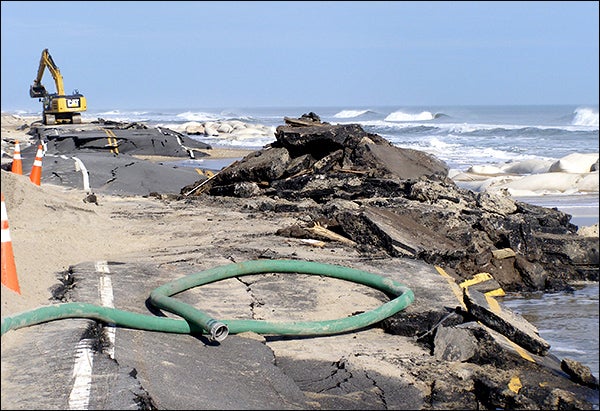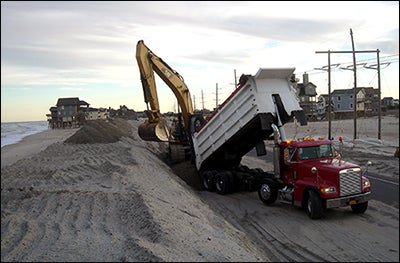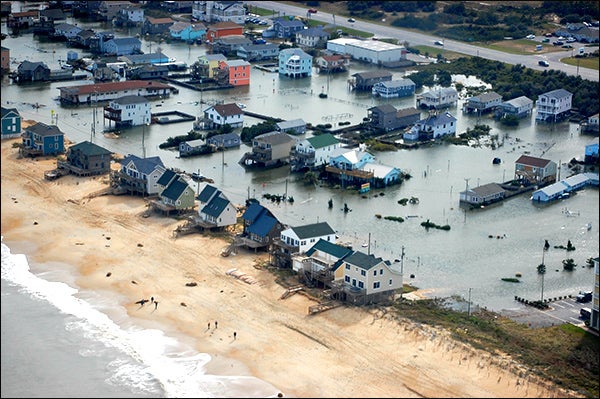SHIFTING SANDS
ECU to partner on coastal restoration research
East Carolina University will soon be researching new ways to maintain and rebuild North Carolina’s cherished coastline following damage from hurricanes and tropical storms.
In a two-year cooperative agreement with the U.S. Bureau of Ocean Energy Management (BOEM), ECU is partnering to evaluate sand resources for coastal resilience and restoration planning through the University of North Carolina Coastal Studies Institute (UNC CSI).

Work along North Carolina’s Outer Banks helps restore habitats destroyed by coastal storms. ECU is joining a partnership to study coastal resources to enhance restoration planning. (Photos courtesy of the North Carolina Department of Transportation)
Scientists from ECU and the UNC CSI will work with the North Carolina Division of Coastal Management and Geodynamics, an oceanography contractor, on the $200,000 project. The research will assist coastal communities recovering from Hurricane Sandy and to restore habitats along the beaches of North Carolina.
BOEM authorized the application of transported sand and other restructuring methods into federal waters following Hurricane Irene in 2011, which restored 7.1 miles of shoreline along North Carolina’s Bogue Banks in 2012.
“We thank BOEM and the federal government for supporting North Carolina’s effort to identify sand resources along its shores,” said J.P. Walsh, an associate professor with both ECU and UNC CSI. “Many coastal communities were impacted by Hurricane Sandy and other recent storms and these areas are critically important ecologically and economically.

“This funding will help inform communities as they work towards coastal resilience and restoration.”
With the agreement, existing geological and geophysical data about North Carolina’s shoreline will be assessed and consolidated, allowing planners to locate sand resources and make recommendations for the most sustainable practices moving forward. That means whenever dredging or coastal nourishment efforts are undertaken in the future, Walsh said, the project will ensure they are done in ways that are compatible with natural sediment transport and biological well-being, as well as stakeholder interests.
The project will also result in easier sharing of sand resource data among all groups involved in coastal resilience planning, which is important in reducing potential storm damage to the residents, economies and infrastructures of North Carolina’s coastal communities.
“This project will help improve our understanding of the quality and quantity of sand deposits offshore for use by local governments and the state in planning future coastal storm damage reduction projects.”
ECU, UNC CSI and its partners will also reanalyze existing data in northeastern North Carolina (north of Cape Hatteras) to develop an updated report of sand resources with the newest available information as part of the project. Areas for future resource surveys will be identified as well.
 Federal funding for the agreement is part of a series of BOEM partnerships with coastal Atlantic states using part of the $13.6 million allocated through the Disaster Relief Appropriations Act of 2013. The legislation is aimed at facilitating research on sand and gravel resources for coastal protection and restoration along the entire Atlantic Outer Continental Shelf.
Federal funding for the agreement is part of a series of BOEM partnerships with coastal Atlantic states using part of the $13.6 million allocated through the Disaster Relief Appropriations Act of 2013. The legislation is aimed at facilitating research on sand and gravel resources for coastal protection and restoration along the entire Atlantic Outer Continental Shelf.
“This agreement demonstrates BOEM’s commitment to work with North Carolina to help coastal communities recover from storms like Hurricane Sandy and enhance resilience efforts for the future,” said BOEM Acting Director Walter Cruickshank. “We are committed to continuing to work in a collaborative manner to help local communities withstand damage from future storms.”